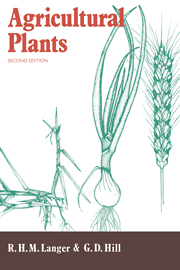Book contents
- Frontmatter
- Contents
- Preface to the first edition
- Preface to the second edition
- 1 World population and crop production
- 2 Plant structure
- 3 Liliaceae
- 4 Poaceae
- 5 Apiaceae
- 6 Asteraceae
- 7 Brassicaceae
- 8 Cannabinaceae
- 9 Chenopodiaceae
- 10 Cucurbitaceae
- 11 Fabaceae
- 12 Lamiaceae
- 13 Linaceae
- 14 Malvaceae
- 15 Papaveraceae
- 16 Solanaceae
- 17 Physiological basis of yield
- Index of specific names
- Subject index
14 - Malvaceae
Published online by Cambridge University Press: 05 June 2012
- Frontmatter
- Contents
- Preface to the first edition
- Preface to the second edition
- 1 World population and crop production
- 2 Plant structure
- 3 Liliaceae
- 4 Poaceae
- 5 Apiaceae
- 6 Asteraceae
- 7 Brassicaceae
- 8 Cannabinaceae
- 9 Chenopodiaceae
- 10 Cucurbitaceae
- 11 Fabaceae
- 12 Lamiaceae
- 13 Linaceae
- 14 Malvaceae
- 15 Papaveraceae
- 16 Solanaceae
- 17 Physiological basis of yield
- Index of specific names
- Subject index
Summary
The Malvaceae consist of about 50 genera and 1000 species, herbs, shrubs and trees, distributed throughout the world. Two genera are of major economic importance: Gossypium containing several species of cotton, and Hibiscus which, apart from its ornamental species, provides a significant fibre crop and a tropical vegetable. Other genera include Malva containing several species of weeds, the mallows; Plagianthus represented in New Zealand by the ribbonwood tree; Hoheria, the lacebark, another tree in the same country. Another genus of interest is Abelmoschus which contains the widely grown vegetable okra, and also the musk mallow, which is cultivated in Java, West India and elsewhere to produce aromatic seed for the extraction of musk oil or ambrette for perfume.
GOSSYPIUM
This is a large and variable genus containing about 30 diploid (2n = 26) and four tetraploid (2n = 52) species. The latter group includes the two most important species, cultivated as fibre crops and for the oil contained in the seed, Gossypium hirsutum which makes up about 95% of world production, and G. barbadense.
Origin and history
The different genomes making up the various species in this genus appear to have originated in several parts of the world including Central America, North and South Africa, the Arabian desert, south-east Asia, and Australia. The main cultivated species which are amphidiploid are thought to have developed in northern South and Central America, although one genome seems to be of African origin and was probably derived from seed that drifted across the ocean.
- Type
- Chapter
- Information
- Agricultural Plants , pp. 299 - 303Publisher: Cambridge University PressPrint publication year: 1991



